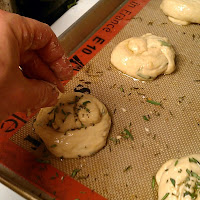To download a copy of the recipe for Sweet and Savory Peach
Dessert Empanadas, click HERE.
 Although it’s probably natural to think of empanadas as
Latin cuisine, by one name or another, some variation of empanadas can be found
in nearly every part of the world.
Although it’s probably natural to think of empanadas as
Latin cuisine, by one name or another, some variation of empanadas can be found
in nearly every part of the world.
It’s easy to understand why this would be. An empanada is a
simple, versatile item made by placing a filling – usually meat, fish, or
vegetables, but sometimes fruit – onto a circle of dough and folding it over.
The filled dough packet is then cooked, usually by frying, and sometimes by
baking. (Think “Hot Pocket” except made with recognized food items.) Needless
to say, in the recipe below the empanadas are baked.
When made as a dessert item, empanadas usually have a sweet
fruit filling. For this recipe, instead of a sweet, pie-type filling, I wanted
to add a little more depth of flavor by adding savory elements as well. In
fact, if you increase the cook time for the filling to make it softer, you’ll
have a pretty good peach chutney. (You might notice in the photos below that I
made a double batch of filling; the leftover got frozen for future use as
chutney.)
Some Cook’s Notes before we begin:
- Because these are dessert empanadas, I cut the dough discs a bit smaller than usual, to about 3-1/2”. If you’re filling these with meat and plan to make a meal of them, I’d recommend cutting the dough discs a bit bigger.
- Also because these are being made into dessert empanadas, I included sugar in the dough. If you want to use this dough for a more traditional meat empanada, I’d recommend omitting the sugar. If you’re really feeling creative, you may even want to add herbs or other flavorings that are compatible with whatever you’ll be filling them with.
- While we’re on the subject of the dough, some empanada-lovers may prefer not to make their own. Fear not; frozen dough discs for making empanadas can be found at most Latin food stores.
- As with any pastry, empanada dough handles easiest when it is kept very cold. Accordingly, you’ll see in the recipe below there are several points at which steps are taken to keep the dough as cold as possible using the freezer. (I find that works better than the refrigerator, especially when using reduced-fat butter substitute.)
This recipe makes about fourteen 3-1/2” empanadas.
To
make the pastry:
Combine ¼ cup of water, 1/8 tsp cider vinegar, and ½ tsp kosher salt the water in a cup and put in the freezer until almost icy. At the same time, place 5 ounces of butter substitute in the freezer to get it very cold, but not frozen.
Combine 3 cups of all-purpose flour and ¼ cup of sugar in the bowl of an electric mixer. Turn the mixer on for a few seconds to get a good mix.
Turn on the mixer till the bowl contents resemble a coarse meal. (A few pea-sized pieces of butter substitute are ok.)
To make the filling:
Add 2 cups of diced peaches. (Fresh are best as long as you can get good ones. If good peaches aren’t available, canned will suffice.) Cook for about another minute until the peaches have just started to brown.
Add the boiled vinegar mixture, ¼ tsp nutmeg (fresh ground is best); ¼ tsp ground ginger; a pinch of ground cinnamon; ¼ tsp hot sauce; and 2 Tbsp kosher salt. Simmer uncovered for 5 – 10 minutes until the peaches soften slightly. While the mixture is simmering, begin preheating the oven to 400 degrees.
To
make the empanadas:
Turn the dough out onto a floured surface and cut in half. Re-wrap one of the halves and place it in the refrigerator until ready to use
.
Roll the other half-dough to about 1/8” thick. (Be careful not to make the dough thicker than this, or the empanadas will lose their lightness and become too crusty for the amount of filling.)
Using a cookie cutter or a small plate, cut out circles of the desired size. (About 3-1/2”- 4” diameter is recommended.)
Apply some egg-wash around the edge and fold other the other half of the cutout, pressing down to seal.
Place the empanadas on a baking sheet lined with parchment or a silicon sheet. Brush egg wash onto each empanada.
Repeat with the other half of the dough.
Hope you enjoy these full-flavored, totally delightful
sweet-and-savory treat! And that you’ll come back for another delicious,
kitchen-tested recipe! Till then, stay well, keep it about the food, and always
remember to kiss the cook. ;-)


















































